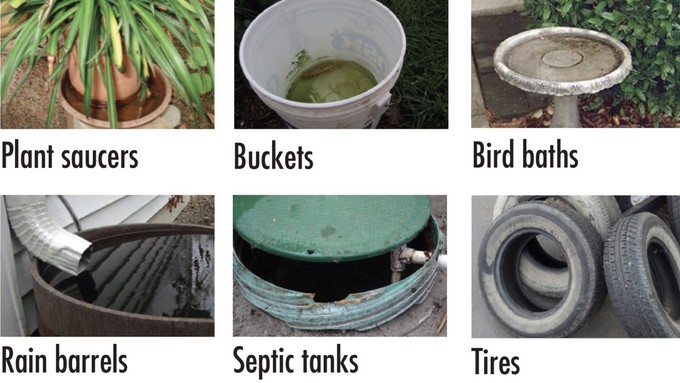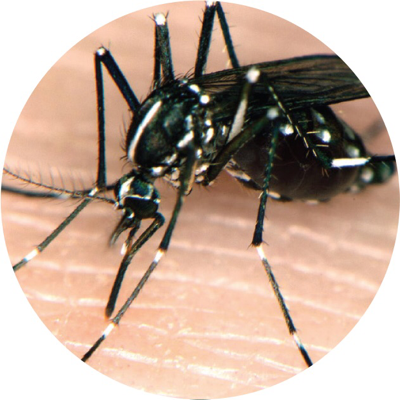
New invasive mosquito found in Sacramento County

These are just a few of the places where water collects outside -- and where mosquitoes can lay their eggs. Photos courtesy of Sacramento-Yolo Mosquito & Vector Control District
This Halloween, scary little monsters could be waiting to bite your arms and ankles – and some don’t wait until dark. They bite in broad daylight.
Mosquitoes seem to be particularly voracious this late October, ready to stick it to this evening’s trick-or-treaters. (They’ve certainly been nibbling on this gardener during late afternoons and evenings.)

An alert by the Sacramento-Yolo Mosquito & Vector Control District brings additional cause for alarm: The Asian tiger mosquito has been found for the first time in Sacramento County.
Aedes albopictus is the second invasive mosquito species to be detected in Sacramento County, joining the yellow fever mosquito (Aedes aegypti). Both are small, dark mosquitoes that bite aggressively during the day. And both have the potential to transmit deadly viruses.
This is how the vector experts found the first tiger mosquito, according to the district’s press release: “The initial detection came as a result of a call from a resident in Carmichael who had reported being bitten during the day. District staff conducted a backyard inspection and found a single mosquito larva in a watering can. In response to this initial finding, field technicians conducted door to door inspections in other homes throughout the neighborhood and found additional Aedes albopictus adult mosquitoes and larvae in surrounding areas.”
Both the tiger and yellow fever mosquitoes lay their eggs in all sorts of vessels – anything that can hold a few spoonfuls of water. When moisture collects in that container, the eggs hatch.
“Now that we have found this second species of invasive mosquitoes, our goal is to limit their expansion as best we can,” said district manager Gary Goodman. “We are mobilizing and responding quickly in order to protect the residents we serve.”
Besides both being day biters, both species of invasive mosquitoes can breed indoor or outdoors, making them doubly hard to control.
“They lay eggs above water in containers such as flower pots, pet dishes, bird baths, kids toys, tin cans, tires and other containers as small as a bottle cap that are commonly found in backyards,” says the vector district.
“Public cooperation is very important and we need your help,” said Goodman. “If you are being bitten by mosquitoes or notice them in your yard, please give the District a call to request a free inspection.”
Although they haven’t done it yet (at least as far as authorities know), both species can transmit several dangerous viruses including dengue, chikungunya, Zika and yellow fever. To do so, the insects need to bite someone carrying that virus.
In Carmichael, vector district field technicians will conduct door-to-door inspections to look for potential mosquito breeding sites, making appropriate treatments as necessary and talking to residents about preventive measures around their home, says the district.
Feel a bite or suspect a problem mosquito? Call 1-800-429-1022 or visit www.FIGHTtheBITE.net.
Meanwhile, wear long sleeves, long pants and mosquito repellent while outdoors. Better safe than bitten.
Comments
0 comments have been posted.Sacramento Digs Gardening to your inbox.
Sites We Like
Garden Checklist for week of July 21
Your garden needs you!
* Keep your vegetable garden watered, mulched and weeded. Water before 8 a.m. to reduce the chance of fungal infection and to conserve moisture.
* Feed vegetable plants bone meal, rock phosphate or other fertilizers high in phosphate to stimulate more blooms and fruiting. (But wait until daily high temperatures drop out of the 100s.)
* Don’t let tomatoes wilt or dry out completely. Give tomatoes a deep watering two to three times a week.
* Harvest vegetables promptly to encourage plants to produce more. Squash especially tends to grow rapidly in hot weather. Keep an eye on zucchini.
* Pinch back chrysanthemums for bushy plants and more flowers in September.
* Remove spent flowers from roses, daylilies and other bloomers as they finish flowering.
* Pinch off blooms from basil so the plant will grow more leaves.
* Cut back lavender after flowering to promote a second bloom.
* It's not too late to add a splash of color. Plant petunias, snapdragons, zinnias and marigolds.
* From seed, plant corn, pumpkins, radishes, winter squash and sunflowers.